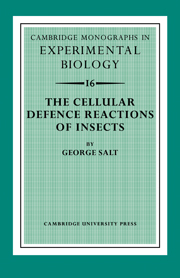Book contents
- Frontmatter
- Contents
- Acknowledgements
- 1 INTRODUCTION
- 2 PHAGOCYTOSIS
- 3 ENCAPSULATION
- 4 NODULE FORMATION
- 5 OBJECTS THAT EXCITE CELLULAR REACTIONS
- 6 THE REACTIONS OF INSECT BLOOD CELLS
- 7 CELLULAR REACTIONS AND IMMUNITY
- 8 A COMPARISON OF INSECT AND VERTEBRATE DEFENCE REACTIONS
- References
- Index of organisms
- Index of subjects
- Plate section
3 - ENCAPSULATION
Published online by Cambridge University Press: 20 April 2010
- Frontmatter
- Contents
- Acknowledgements
- 1 INTRODUCTION
- 2 PHAGOCYTOSIS
- 3 ENCAPSULATION
- 4 NODULE FORMATION
- 5 OBJECTS THAT EXCITE CELLULAR REACTIONS
- 6 THE REACTIONS OF INSECT BLOOD CELLS
- 7 CELLULAR REACTIONS AND IMMUNITY
- 8 A COMPARISON OF INSECT AND VERTEBRATE DEFENCE REACTIONS
- References
- Index of organisms
- Index of subjects
- Plate section
Summary
‘Encapsulation’ and ‘encystment’ were defined by Maupas (1899), who restricted the first to a reaction of the host, the second to an activity of the parasite. A capsule is a covering laid down by the host around a parasite or other foreign body; cysts are coverings formed by parasites about themselves. Unfortunately, these terms have sometimes been used as though they were interchangeable, and it is then difficult or impossible to understand what was meant. Authors writing in French sometimes use ‘capsule’ and sometimes ‘nodule leucocytaire’. Well developed nodules are indeed very similar to capsules, but a distinction can be drawn (p. 51) and is perhaps worth preserving. There has also been some confusion in the literature between capsules and tumours, but that is unnecessary in theory whatever it may be in practice: a capsule is formed and increases in size by the aggregation and addition of cells; a tumour grows by the division and consequent proliferation of cells.
Encapsulation has not been observed to take place in vitro, and the process is therefore known from the examination of hosts dissected at intervals after implantation of a parasite or other foreign body. Since the time required for complete encapsulation is relatively long, measured in hours or days, the course of events can be described with some confidence by examining hosts at frequent intervals.
So far as present evidence goes, encapsulation is carried out exclusively by blood cells.
- Type
- Chapter
- Information
- The Cellular Defence Reactions of Insects , pp. 31 - 50Publisher: Cambridge University PressPrint publication year: 1970

